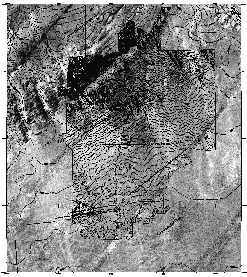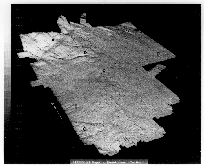Geologic Features of the Sea Bottom Around a
Municipal Sludge Dumpsite near 39øN, 73øW,
Offshore New Jersey and New York: U.S. Geological Survey Open-file
Report 94-152
A regional view of the continental slope and rise off the
northeastern U.S. depicted by the GLORIA survey
(EEZ-SCAN 87 Scientific Staff, 1991)
shows that, in
comparison with neighboring areas to the northeast and southwest, the
dumpsite area is not traversed by major submarine channels. To the
northeast lies Hudson Canyon, the largest canyon of the U.S. east coast
continental slope, and its well defined meandering channel on the
continental rise. To the southwest the continental slope is
intricately dissected by a number of canyons and valleys which feed
into a complex system of channels and less well-defined, probably
debris-choked, flow pathways on the rise.

GLORIA sidescan-sonar mosaic of
slope and rise off the mid-Atlantic coast of the U.S. shows the study
area in relation to features of neighboring areas of the sea floor
Bathymetric contours at 200, 1000, 2000, and 3000 meters. The areas
of site study, Sea Beam bathymetry, and municipal sludge dumpsite
are outlined.
Overlying the GLORIA images of the dumpsite area with the Sea Beam
bathymetric contours shows a subdued but complex surface of
the continental rise in the dumpsite area.



Center: Composite illustration of GLORIA imagery and bathymetric
contours of the dumpsite study area. The central part of this area was
mapped using Sea Beam data, and is shown using a 10-m contour interval;
contours of the peripheral area, at a 100-m interval, from Escowitz
and others (1988); of the northeastern part, kindly provided by
A. Shor). Note the congruence of the GLORIA backscatter pattern and
the bathymetric contours. Central dark colored deposit separates lower
areas, which finer scale imaging (below) shows to be furrowed. Left
image: GLORIA imagery of study area without overlay. Right image:
Contour lines (Robb, 1992) and location
of deep-towed 120-kHz sidescan-sonar
imagery. Rectangle shows location of data illustrated below.
While the adjacent continental slope, to landward, has an average
declivity of about 3.5o, the average declivity of the continental rise
is about 0.45o, changing from about 1.9o in the uppermost part near the
continental slope to about 0.29o in the seaward part of the study
area. There is an intermittant trough at the base of the
continental slope along a band of sedimentary mounds
on the upper continental rise (see A on the perspective
diagram below).

Perspective image of Sea Beam bathymetric data set. View from
southwest, looking northeast, across upper rise. Lower part of
continental slope on upper left. Brightness of each grid cell in this
image is varied with respect to a vertical sun angle and the viewer's
position. Note the terrace or trough at the base of the continental
slope (A), the slope-parallel wrinkles(?) (B), an area of probable
slide deformation on the upper rise (C), and depressions (D). Slight
north-south bands of noise show where data swaths abut. Image courtesy
of Robert C. Tyce, University of Rhode Island.
There are hillocks and depressions having relief of 20-30 m on the rise
surface, especially in the southern part of the mapped area.
Continuous, well-defined channels are absent on the rise in the
dumpsite area. Instead, broad flat low areas that are generally
distinguished on the GLORIA images as high backscatter regions extend
seaward from the debouchment of continental slope canyons or chute-like
valleys.
Subbottom profiles show faulting and displacement of subsurface strata
on the rise near the base of the slope as well as fracture and tilting
of tabular blocks of surficial sediments; uneven sea-floor surfaces are
observed at greater distances offshore, implying that blocky debris
traveled long distances.

Above: Airgun seismic-reflection profile along upper continental rise
near base of slope shows strata of uppermost rise, slump structures,
and faults. Labeled scarp is shown in higher resolution profile
below.

Above: High-resolution 3.5-kHz subbottom profile shows faulting and
tilting of surficial acoustically laminated strata on upper rise; graben
created by slumping of upper rise sediments. Labeled scarp is
crossed by airgun profile above.
In places acoustic profiles show subsurface
reflecting surfaces that are truncated at the sea floor. In other
places there are smooth and nearly acoustically transparent
mud-flow(?) deposits or deposits of blocky debris.

High-resolution 3.5-kHz subbottom profile across the seaward part
of study area on upper continental rise. Arrow marks transition
between area of smooth surface to the northeast, and rough,
acoustically impenetrable surface, probably of blocky debris-flow
deposits to the southwest.
Boulders derived from mass wasting of the continental slope are widely
distributed on the surface of the continental rise. They were observed
during a number of Alvin dives off the New York Bight (Hanselman and Ryan, 1983; Rawson and Ryan, 1983; Ryan and Farre, 1983). A boulder
sampled during Alvin dive 2163 (1989) was identified to be of middle
Eocene age (C. W. Poag, personal commun., 1990). Many boulders,
commonly meters in diameter, which visually resemble the Eocene
mudstone, were observed on the continental rise 12 to 45 km from the
base of the slope.


Boulders observed during dives of RV Alvin in 1989. Boulders are
about 2 m in diameter. A (left). Dive 2163, water depth about 2485 m;
B (right). Dive 2165, water depth about 2405 m.
Smaller fragments (>10 cm in diameter) of semiconsolidated Eocene
mudstone were recovered from benthic trawls on the upper continental
rise as far as 11 km from the base of the slope. Fields of tens of
boulders were observed with a short-range sonar system used by Alvin
during dive 2165. Some boulders on the rise are associated with
channels, where they may have been transported by turbidity currents or
debris flows. Boulders observed during Alvin dives 2162, 2164, and
2165 near the sludge-dump area are not associated with channels. The
120-kHz sidescan-sonar surveys revealed offshore-trending ridges and
furrows commonly associated with boulder-like targets, in the regions
of high backscatter on the GLORIA mosaic, near the central part of the
dumpsite area (Robb, 1991).



Left: 120-kHz Sidescan-sonar tracklines (vehicle tracks) in relation to
bathymetry. Rectangle locates next image.
Center: Mosaicked images over furrowed bottom area; 10-m contour interval.
Closed-contours show depression (upper right quadrant: 2500-m contour
identified) and the neighboring, downrise, elliptical high (near upper
center of image). Rectangle locates the swath shown in the next
image.
Right: A single swath of AMS-120 sidescan-sonar imagery, 900 m
wide x 3300 m long. See location to left.
- To continue, click on:
- Discussion...
- Conclusions...
- References Cited...
- Illustrations Summary
- Or, to review, click on:
- Abstract...
- Introduction...
- Data and Methods...
- (Bathymetric map)
- (GLORIA mosaic)
- Description of the sea floor...
******
[an error occurred while processing this directive] 


